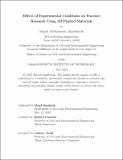Effects of Experimental Conditions on Fracture Research Using 3D Printed Materials
Author(s)
Almubarak, Majed Abdulsattar
DownloadThesis PDF (36.78Mb)
Advisor
Einstein, Herbert H.
Terms of use
Metadata
Show full item recordAbstract
The fracturing behavior and mechanical characterization of rocks are important for many applications in the fields of civil, mining, geothermal, and petroleum engineering. Laboratory testing of rocks plays a major role in understanding the underlying processes that occur on the larger scale and for predicting rock behavior. Fracturing research requires well-defined and consistent boundary conditions. Consequently, the testing design and setup can greatly influence the results.
In this study, a comprehensive experimental program using an artificial material was carried out to systematically evaluate the effects of different parameters in rock testing under uniaxial compression. The parameters include post-processing curing, printing orientation, compression platen type, specimen centering, loading control method and rate, specimen size, specimen cross-sectional geometry, boundary constraints, and flaw parameters.
The specimens were prepared using a 3D stereolithography printer utilizing clear resin material. Identical pre-existing quasi-elliptical (ovaloid-shaped) flaws were placed in the center of each specimen. The specimens were subjected to unconfined compression using a Baldwin load frame. The testing setup included a high-speed camera and a high-resolution camera for visual analysis of the fracturing processes.
The results show that these testing conditions have a significant effect on the mechanical behavior of rocks. Post-processing curing increases the strength of the material, with longer curing times resulting in higher material strength. Different printing orientations exhibit varying strengths. Using a fixed compression platen helped reduce bulging of the material. Centering of the specimen played a critical role to avoid buckling and unequal distribution of stress. Slower displacement rates can control the energy being released once failure occurs to prevent the specimen from exploding. Larger specimens generally fail at lower stresses compared to smaller specimens. Also, the frictional end effects were investigated by comparing lubricated and non-lubricated end conditions. Very importantly, the study also identified variations in crack initiation and propagation between specimens with internal flaws and specimens with throughgoing flaws. This investigation showed that tensile wing cracks appeared in specimens with throughgoing flaws, while wing cracks with petal cracks were associated with the internal flaws. It also showed that the mechanical properties are influenced by the inclination of the flaws and established that specimens with internal flaws generally exhibit higher material strength compared to specimens with throughgoing flaws.
The systematic analysis presented in this work sheds light on important considerations that need to be taken into account when conducting fracture research and adds knowledge to the fundamental understanding of how fractures occur in nature.
Date issued
2023-06Department
Massachusetts Institute of Technology. Department of Civil and Environmental EngineeringPublisher
Massachusetts Institute of Technology